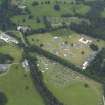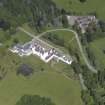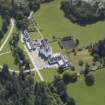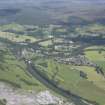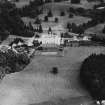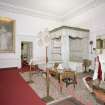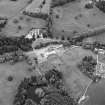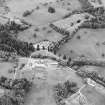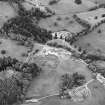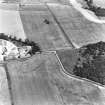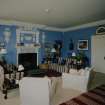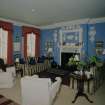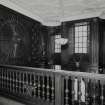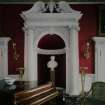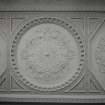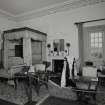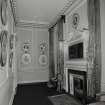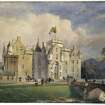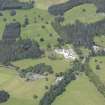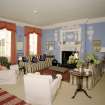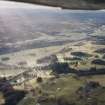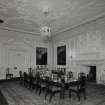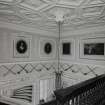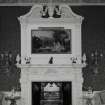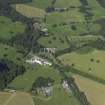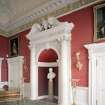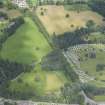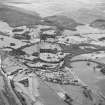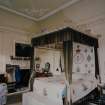Blair Castle
Country House (13th Century), Hospital (First World War)
Site Name Blair Castle
Classification Country House (13th Century), Hospital (First World War)
Alternative Name(s) Atholl Estate; Blair Castle Policies; Blair Castle Auxiliary Hospital; Blair Castle Estate
Canmore ID 25802
Site Number NN86NE 5
NGR NN 86577 66186
Datum OSGB36 - NGR
Permalink http://canmore.org.uk/site/25802
First 100 images shown. See the Collections panel (below) for a link to all digital images.
- Council Perth And Kinross
- Parish Blair Atholl
- Former Region Tayside
- Former District Perth And Kinross
- Former County Perthshire
NN86NE 5.00 86577 66186
(NN 8657 6618) Blair Castle: Cumin's Tower (NR)
OS 6" map, Perthshire, 2nd ed., (1900)
NN86NE 5.01 NN 86444 66216 Garden and Terrace; Statues
NN86NE 5.02 NN 87027 66343 Walled Garden; Greenhouses; Gate; Statues
NN86NE 5.03 NN 87276 65451 Front Lodge
NN86NE 5.04 NN 87028 66274 Statue of Hercules
NN86NE 5.05 NN 86488 66182 Walled Garden, Sundial
NN86NE 5.06 NN c 865 664 The Obelisk
NN86NE 5.07 NN 86504 66445 Statue of Diana
NN86NE 5.08 NN 86235 67220 Lady Jean's Well
See also:
NN86NE 44 NN 869 662 Enclosure (possible)
NN86NE 45 NN 867 657 Ring-ditch (possible)
NN86NE 46 NN 869 657 Ring-ditch (possible)
Blair Castle, the traditional seat of the Dukes of Atholl, is exceedingly large, having grown through numerous phases and extensions and undergone three major reconstructions in style. The last reconstruction copied earlier styles so that it is impossible, without close inspection, to determine where ancient work ceases and modern begins - the more so as the entire building is harled and whitewashed. John Comyn of Badenoch is stated to have begun to build a fortalice at Blair in 1269. Comyn's or Cumming's Tower is still so called, but only the foundations can represent this stronghold.
N Tranter 1962-70.
As described by Tranter. The names Blair Castle and Cumin's Tower verified.
Visited by OS (R D) 15 September 1967.
NN86NE 5.00 86577 66186
Architect: J Macintyre Henry 1903 alterations
Joseph Mitchell 1860 new lodge at West approach
R & R Dickson 1840 designs for new entrance hall and tower
Roger Morris 1742 designs for the top of the broomknowe, coachhouse & stables
Abraham Swan design for bridge, lodges and great stair
Henry & Maclennan 1908 new porch
George Steuart (?) 18thC alterations
John Douglas 1748 designs for additions
James Winter 1743 additions
Alexander Mitchell 1840/1 proposed improvements
Thomas J Mitchell 1847 new lake
David Bryce 1869 additions
Sir Robert Lorimer 1920/1 additions
James C Walker 1885 new bedroom
NMRS REFERENCE
letter from John Stirling Maxwell
"William Adam never worried about appropriateness. When the Duke of Atholl asked him to design comfortable additions to his rather grim castle at Blair he built two magnificent rooms which would have done credit to any palace in Europe. The dining room with its deeply recessed windows and elaborate plaster work framing large pictures of the waterfalls and rivers in the forests of Atholl is quite a suitable setting for the hospitality of a Highland chieftain. The great drawing room above, on the other hand, with its deep cove, elaborate plaster work and gilding and sunk walls is about as incongruous as any room could possibly be in a Highland castle. The long family wing attached to the castle on the south side has many bedrooms and public rooms every one of which is a perfect example of mid XVIIIth century decoration. The great drawing room, incongruous though it is, used to look very lovely when full of guests at the time of the Atholl Gathering when Bardie's father and mother used to entertain a large party of friends. Such parties would be impossible in these days. I remember the Duchess used to complain that during that week, including family and servants, she had to cater for more than one hundred people staying the house - no easy matter even with larders full of salmon, grouse and venison.
Yours very sincerely,
John Stirling Maxwell."
NMRS REFERENCE
Dining Room " finest room in Scotland" Lorimer Sir John Stirling Maxwell Fairlie Mss
EXTERNAL REFERENCE
SRO
Fortification
Draught plan of the fortification intended at the Blair of Atholl. c. 1690 GD 26/9/113
Diary of John Waldie, Hendersyde Park, Kelso GD 1/378/30
May 11th 1826 - May 24th 1827
Desc. p. 75 Unfavourable
gloomy whitewash - old castellated roof off looks like a barrack - capital rooms - rich style of carving and finish - great air of neatness and comfort.
NMRS PLANS
Lorimer
LOR/BLAIR CASTLE/1 Insc: "For His Grace the Duke of Atholl. Proposed alterations and additions"
Survey plan of servants quarters.
Preliminary sketch on tracing. (pencil and crayon)
n/s
n/d
NMRS PRINT ROOM
Inglis Photograph Collection Acc No 1994/90 exterior
Photographic Survey (June 1960)
Photographic survey by the Scottish National Buildings Record/Ministry of Work in June 1960.
Photographic Survey (June 1960)
Photographic survey by the Scottish National Buildings Record in June 1960.
Photographic Survey (July 1961)
Photographic survey by the Scottish National Buildings Record in July 1961.
Photographic Survey (1962)
Photographic survey by the Scottish National Buildings Record/Ministry of Work in 1962.
Publication Account (1987)
The imposing white-harled Scots-Baronial exterior of Blair Castle dates from the 1870s when David Bryce of Edinburgh was commissioned by the 7th Duke of Atholl to remodel and extend the early Georgian mansion known as Atholl House. This building in its turn incorporated the truncated remains of an earlier Blair Castle. The whole history of the building appears to follow this pattern back to the earliest building reference of 1269. Fortunately many of the interiors survived one or more of these remodellings leaving a rich legacy of period interiors from the 18th and 19th centuries. The most magnifIcent of these are the classical interiors from the 1747 to 1758 remodelling. These were designed and executed by craftsmen of the highest order. The plasterwork in the principal apartments is the work of Thomas Clayton of Edinburgh. The woodwork is by Abraham Swan and the stone chimney-pieces are the work of Thomas Carter of London. Much of the 18th century and Regency furniture is of English manufacture, although some fme French pieces are in evidence.
Blair Castle has had many Royal connections. Queen Victoria visited Atholl House in 1844. In 1745, Prince Charles Edward Stuart stayed for a few days in the earlier Blair Castle. Mary Queen of Scots visited and was entertained with a hunt during which three hundred and sixty red deer and five wolves were killed. Edward III of England stayed at Blair in 1336 and in
the years after the Wars ofIndependence, Blair was owned by Robert II and his son WaIter.
The present Duke of Atholl boasts the only surviving private army in Europe, the Atholl Highlanders, who regularly parade in the castle grounds. The last siege of the building took place early in 1746 making this the last house on the British mainland to withstand a siege.
In addition to the architectural and historic interest of the buildings, Blair Castle also houses a number of excellent collections ranging from antique furniture, paintings, china, valuable books, documents, embroidery and lace to Atholl family trophies, mementos and a natural history collection.
The village of Blair Atholl houses a working corn (oats) mill and country museum.
Possibly Bryce did more than any other Scottish architect to break down the refinement of the late Georgian era. His boldness of concept and brashness of detail produced some very exciting buildings. On the whole these buildings have suffered badly, being constructed on such a grand scale that they have proved almost impossible to maintain on any but the largest estates. Many were demolished in the post-war period at a time when their architectural value was not fully appreciated. At Kinnaird Castle (NO 634571), 1854-56, Bryce reconstructed a Classical house as a French Gothic chateau to create one of the most splendid houses in the region. Unfortunately a fIre in 1921 resulted in the loss of its romantic roof-line and splendid interiors. Otherwise the house survives and remains the seat of the Earl of Southesk.
Information from ‘Exploring Scotland’s Heritage: Fife and Tayside’, (1987).
Project (March 2013 - September 2013)
A project to characterise the quantity and quality of the Scottish resource of known surviving remains of the First World War. Carried out in partnership between Historic Scotland and RCAHMS.
Standing Building Recording (6 July 2021 - 7 July 2021)
A standing building survey was carried about on the South Wing of Blair Castle by Derek Hall Archaeologist and Ceramic Specialist between 6 July and 7 July 2021 as part of the conditions stipulated by Perth and Kinross Heritage Trust in advance of the development of the wing.
It is quite clear that the South Wing at Blair Castle has been subject to several alterations and additions throughout its life and that the proposed alterations should be viewed as part of the process of ensuring the continued use of an active, inhabited building.
The author feels that the photographic survey and written notes of the South Wing at Blair Castle are an adequate record of the building prior to its refurbishment. He would recommend that any newly exposed architectural elements are photographically recorded. The final decision on this however rests with Perth and Kinross Heritage Trust.
Information from: Derek Hall Archaeologist and Ceramic Specialist, 16 July 2021
OASIS ID: derekhal1-425318
Standing Building Recording (6 July 2021)
NN 865 661 On 6 July 2021 a photographic and written survey was carried out on all of the sites of the proposed downtakings associated with the refurbishment of the interior of the South Wing of Blair Castle.
Archive: NRHE
Funder: Blair Castle Charitable Trust
Derek Hall
(Source: DES Vol 22)










































































































